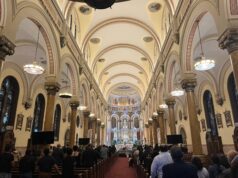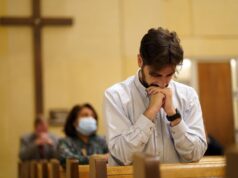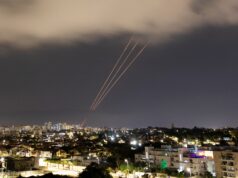
“Don’t call me a saint,” admonished Dorothy Day, journalist, activist and co-founder of the Catholic Worker Movement. “I don’t want to be dismissed so easily.”
While Day fiercely sought to avoid holy titles during her lifetime, there are many Catholics who hope she will one day have “saint” attached to her name.
But for every Dorothy Day — or St. Teresa of Kolkata, St. Oscar Romero or St. John Paul II — there may be hundreds, even thousands, of anonymous potential saints who are not raised to the altars for a very simple reason: Their advocates just can not afford it.
There are only 15 American saints and blesseds — but dozens of Americans declared “venerable” or “servants of God” are still awaiting elevation.
The sainthood process entails expenses for research, travel, translation and, if the cause progresses, beatification and canonization ceremonies. On average, costs have been reported to total around $250,000 — with some high-profile causes potentially topping $1 million.
While ultimately conducted by the Vatican’s Dicastery for the Causes of Saints, causes are typically initiated by a diocese, religious order or nonprofit lay group. The intricacies of the canonization process — with stages marked by the titles “servant of God,” “venerable,” “blessed” and “saint” — also poses a challenge for under-resourced dioceses.
While only one Indigenous North American — St. Kateri Tekakwitha — has achieved it, the six American Black Catholics with causes underway have waited a total of 720 years for sainthood: Pierre Touissant (1766-1853), Father Augustus Tolton (1854-1897), Mother Mary Lange (1784-1882), Henriette DeLille (1813-1862), Julia Greeley (1833?-1918), and Sister Thea Bowman (1937-1990).
Ralph E. Moore Jr., a lifelong Catholic and African American parishioner of St. Ann Catholic Church in Baltimore and a member of its Social Justice Committee, has organized a canonization letter-writing campaign to Pope Francis, urging him to advance their sainthood.
“Not having enough money is one of the reasons there are no Black saints from the United States,” Moore wrote in his April 13 “Moore Report” in AFRO News. He minced no words in saying that today Black Catholics do not have recognized saints from this country as a result of the church’s “contradiction of the Gospels” by white Catholics engaging in slavery and segregation, preventing generations of Black Catholics from entering the priesthood, episcopate and religious life up to the latter half of the 20th century. This has left Black Catholics with far fewer resources to mobilize compared to white Catholics.
Moore said canonization costs become a kind of “poll tax which served as a precondition of exercising the right to vote (going back to the late 19th century in some states).”
On the low end, the cost for all six could end up $1.5 million or — as Moore pointed out — as much as $6 million on the high end once the complicated process is complete.
In addition to undisputed holiness, there is intense research, reams of paperwork, continuous fundraising, potential discrimination — and sometimes, a few unanticipated roadblocks.
“I think the most frustrating thing sometimes is being able to accumulate the information that is needed,” said Father Len Plazewski of the Diocese of St. Petersburg, Florida, vice postulator for the canonization of the Martyrs of La Florida, a group of Native American and Spanish Catholics — priests and laypeople — killed in Florida between 1549-1712.
“In the case of martyrdom, it’s not enough to know the person died. How did they die? Who killed them? What was the motivation of the killer? Those things have to be known,” Father Plazewski explained. “We’ve had a couple of dead ends along the way that kind of delayed us.”
That delay spans more than 300 years, and three previous attempts to forward the cause. Undeterred, Father Plazewski cheerfully observed, “This is the fourth time — but the fourth time is the charm.”
Supported by a lay association, eight dioceses have marshaled their resources for the Martyrs of La Florida — six of the seven dioceses of Florida, the Diocese of Savannah, Georgia, and the Diocese of Richmond, Virginia.
For the La Florida martyrs, Catholicism “was not just something foreign missionaries bought,” said Father Plazewski. “It was deeply inculcated in the lives of these people, so much so that they chose suffering and death over denying their faith.”
Addressing the lack of Native American saints, Father Plazewski suggested “there’s a bit of injustice with the North American Martyrs — St. John de Brebeuf, Isaac Jogues and companions; it’s the eight Jesuits. Well, yes — those eight Jesuits were martyred; died for the faith. But along with them were native peoples — Hurons and Algonquin peoples — who suffered just as terribly, and were also martyred. However, they were not included in (that) cause.”
The discrepancy was indirectly highlighted by St. John Paul II in a 1983 visit to Canada where he paid tribute to Joseph Chiwatenhwa, his wife Marie Aonetta, and their family members — Wendat (Huron) contemporaries of the 17th-century Jesuit martyrs — saying they “lived and witness to their faith in a heroic manner … and provide even today eloquent models for lay ministry.” However, despite this strong papal praise, no formal cause has opened in Canada.
Similarly, St. Kateri Tekakwitha’s contemporaries, Haudenosaunee (Iroquois) martyrs from Kahnawake, Quebec, who died for their faith in upstate New York in the 1690s, also have received no formal, universal recognition.
Journalist John Allen Jr. — editor of the Catholic news site Crux and a senior Vatican analyst for CNN — told OSV News, “I think there probably are causes that never get off the ground, simply because there’s no organization that has the resources to be able to bring it forward. In terms of identifying saints that never were, they never register on the radar screen.”
Allen gave just one example: “I’m aware of religious orders that have made conscious decisions not to invest in trying to move particular causes forward because they think there are better uses for their limited resources.”
According to Allen and others, the opaqueness of the process has led to allegations of both confusion and price-gouging, with unscrupulous researchers overcharging for various services. In response, the Vatican’s Dicastery for the Causes of Saints published a list of expected fees. But that, too, generated controversy. “There are some people who think making saints should not be like ordering a meal in a restaurant,” said Allen, “where you’re given a menu, and prices are listed for various things.”
Geography also is a determining factor. “My guess,” Allen said, “would be that there are all kinds of presentable sainthood candidacies across the developing world that never get off the ground — not because there’s no sanctity, but because there’s no resources.”
Another Native American cause is that of He?áka Sápa — commonly known as Servant of God Nicholas Black Elk (1863-1950) of the Oglala Lakota people. A survivor of the 1890 Wounded Knee Massacre, the Lakota holy man became Catholic in 1904, and is reputed to have brought more than 400 people to baptism.
“I read ‘Black Elk Speaks’; it was required reading in high school,” said Deacon Bill White, who is Lakota and the diocesan postulator for Black Elk’s cause, speaking of a 1932 biography by John G. Neihardt of Black Elk’s early life. However, the book doesn’t mention Black Elk’s Catholicism, “so I was kind of in awe that he was a catechist,” Deacon White said.
A deacon ministering in the Diocese of Rapid City, South Dakota, Deacon White began his role as the diocese’s postulator for Black Elk’s cause in 2017, and told OSV News the process has been fairly smooth, if not without its challenges. Rapid City is among U.S. dioceses identified and supported as “Extension dioceses” by Catholic Extension. The designation, according to Catholic Extension, indicates “isolated and/or financially under-resourced Catholic dioceses.”
“We are a small diocese — and just like other dioceses, I think we’re struggling,” he said. Given the impact of the COVID-19 pandemic, he said, “Financially, everybody’s probably not contributing as much as they used to.”
The Black Elk cause was financially assisted by the Knights of Columbus, the largest Catholic fraternal organization in the world. The Knights also have financially supported the cause of Father Emil J. Kapaun (1916-1951), a U.S. Army chaplain and Medal of Honor recipient from Kansas who died in a North Korean prisoner of war camp.
Scott Carter, coordinator for Father Kapaun’s cause in the Diocese of Wichita, Kansas, told OSV News that Father Kapaun’s sainthood progress was delayed after being introduced in 1993 by the predecessor for the U.S. Military Archdiocese. He believed finding the personnel and possibly the funds played a role before the Diocese of Wichita took up the cause in 2008.
In 2021, the U.S government identified Father Kapaun’s remains, which are now entombed in Wichita’s Cathedral of the Immaculate Conception.
While the Vatican maintains a fund for “poor causes,” it’s impossible to assist all those who need help.
And that is a disappointing prospect to Carter.
“The way the Holy Spirit has used Father (Kapaun)’s life,” Carter said, “I would hate to see someone who’s deserving — someone who can make a big impact; who really inspires people — who struggles to move forward just because of the cost.”








